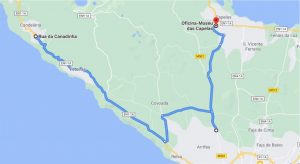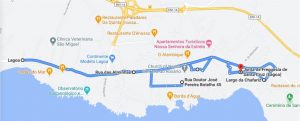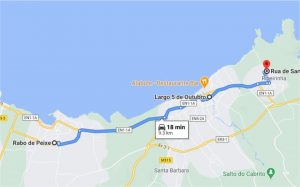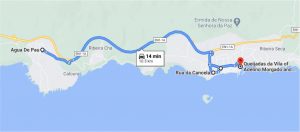
Island of São Miguel
Green, populated by lakes and streams, plains and mountains, flowers and cattle, the largest island of the Azores has the just reputation of being an emerald in the middle of the Atlantic—which bathes its beaches and cliffs.
Itinerary – Ponta Delgada (Center)

1. Let’s start on foot, on the west side of the city (Rua da Cruz), with a visit to the embroidery studio of Mário dos Reis Rodrigo—decades of experience and creativity in traditional satin stitch using blue thread on white linen, certified by the collective mark Artesanato dos Açores. (Mapa)
2. When going up Pedro Homem Street, take a look at the ‘Pele e Osso’ atelier and shop, by artisan Fábio Oliveira, whose original and uniquely tailored fashion creations (bags, shoes, accessories) made of genuine leather and bearing appealing colors guarantee maximum originality and authenticity. (Mapa)
3. Walk a little further and drop by the ‘Brui Gallery’, at Água Street; founded by Gregory le Lay, it brings together 3 artisans who work paper, in different shapes and textures: Gregory, who photographs, draws and articulates fragmented worlds; Anna Bruyére, who manufactures paper from fibers such as vegetables, leaves, bark or algae; Elga Martin, who gives paper shape and color by modeling and engraving. (Mapa)
4. At Padre Serrão Street, close to the municipal market, visit the store and studio “Matéria 47” that combines the works of Inês Ribeiro and Joana Fernandes, a ceramist and a weaver. With extensive experience in visual arts and training, these artisans create unique pieces, made to order, and always full of creativity. (Mapa)
5. Stop at Hugo Raposo’ workshop and enjoy the sounds he creates by giving life to the instruments he builds: the Portuguese guitar, Coimbra guitar, Fado guitar, mandolin, cavaquinho (similar to the ukulele) and Azorean guitar, the latter certified as Artesanato dos Açores. (Mapa)
6. Going up to Rua de São Gonçalo, at Azores CraftLab – Incubadora de Artesanato dos Açores, you can find the innovative and fascinating work of Zsombor Keresztes who, using wood found on the beach or wood from invasive species, designs and builds appealing and useful pieces by hand, respecting the grain and natural shape of this raw material. (Mapa)
7. Still at Azores CraftLab, the work of Romeu Bettencourt, winner of the Revelation Designer Award in Jewelery by the Portuguese Jewelery and Watchmaking Association in 2016, seduces and fascinates with its original language. Giving primacy to gold and precious stones, his work has stood out on the national scene. (Mapa)
Itinerary – Ponta Delgada (County)

1. Within the municipality of Ponta Delgada, to the west, is the parish of Candelária, where you can discover the “Quintal dos Açores” brand, founded in 1997 by Fernando and Helena Sousa, who create several unforgettable sweet flavors (fruit jams and jellies, honey) and savory flavors (pepper and lupine preserves, as well as pickles) from the produce that grow in their farm. (Mapa)
2. Still in Candelária, Catarina Alves gives life to materials as diverse as Japanese cedar wood, ignimbrite stone or cork, creating jewelry pieces of unique beauty—‘Pedras de Lava’ is inspired by Nature, reusing what it generously offers us. (Mapa)
3. In the parish of Arrifes, in the outskirts of the city, taste the fresh and healthy flavors of ‘Queijaria São Miguel’: either in traditional packaging or wrapped in a leaf of the wild ginger lily plant, these cottage cheeses are made from cow’s milk, goat’s milk, or a mixture of both; not forgetting ‘Queijo do Rei’, the well-known cured cheese. (Mapa)
4. In the village of Capelas there is a real time travelling machine—the Oficina-Museu (a museum and a workshop together) founded in 1998 by Manuel João Melo takes us back to traditional centuries-old arts and crafts scenarios; there is also a store where you can find Nativity scenes and figurines, weaved fabric, and many creations made from fish scales and fig pit, these certified by the collective brand Artesanato dos Açores. (Mapa)
5. Finish this tour still in Capelas, at ‘Tramada’, the environment-friendly atelier of weaver Fátima Ramos, who combines natural fibers and vegetable dyes and weaves beautiful patterns by means of traditional looms. (Mapa)
Itinerary – Lagoa

1. In the town of Lagoa, the first stop will be at the Social and Cultural Center of Atalhada, a project that was born out of a desire to fight poverty and provide jobs, in this case to 12 women. This Center brings together several workshops, a multiservice cooperative—with embroidery, weaving, carpentry— and a pastry shop. (Mapa)
2. Using the fibers of plants as flax, dragon tree, southern cattail or corn, as well as various fabrics, Maria Silveira creates jewelry and dolls, dried flowers and nativity scenes. Visitors can watch as this artisan—the soul of ‘Casa da Mata’—gives shape and life to her handicrafts. (Mapa)
3. Founded in 1862, Cerâmica Vieira, an iconic company in Lagoa, creates and produces incomparable pieces of earthenware and ceramics using techniques that time and experience have eternalized. With a predominance of blue on a white glazed background, the pieces can be both utilitarian and decorative—or tiles and door numbers. (Mapa)
4. In a more secluded area of Lagoa, fashion designer Isabel Roque charms our way through her creations: be it in ready-to-wear fashion, be it made-to-measure, haute couture or fashion consultancy, she intertwines the concepts of modernity and timelessness. (Mapa)
5. Aromatic and medicinal herbs—as lavender, thyme, lemon grass, lemon verbena—fill the life of Randal Gladwin who, since his youth, was interested in the field of botany, having developed this business since 2002. (Mapa)
6. As a young man, João Arruda was fascinated by the typical figurines of Lagoa. Later, he learned from the best: master figurine-maker Arsenio Moniz. Today, this artisan is an essential reference, giving life to figurines that are used in the traditional nativity scenes, such as pilgrims, Holy Ghost singers, traditional outfits or regional architecture. (Mapa)
7. Handmade and sustainable soap-making, using regional and natural products, is the basis of “Flora Azorica”, created by Susana Benevides. Due to being a member of the international Soapmaking Natural Ingredients guild, the artisan has been able to combine the most innovative techniques with the most environmentally-friendly resources. (Mapa)
Itinerary – North Coast

1. The first stop on the north coast of the island is at Calhetas, where we will meet the work (with endogenous or recycled wood) of artisan Mário Jorge Medeiros in his studio called “MADLab”: lamps, furniture, decorative items with delicate lines that complete the environment of a modern and elegant home. (Mapa)
2. In the village of Rabo de Peixe, pottery, ceramics, tiles, fish scale jewelry, basalt stone and seeds meet at ‘O Quadradinho’, the shop and studio of artisan Maria Cristina Borges. (Mapa)
3. Isabel Silva Melo, a Fine Arts teacher, has won the national prize for Crafts in New Talents, thus giving greater impetus to her passion as a ceramist, in which each piece is molded by hand. But all the artistic work she has developed, whether it’s with fish scales, Nativity scenes or figurative ceramics, is worthy of the seal of the Artesanato dos Açores certified brand. (Mapa)
4. In the town of Ribeira Grande, let’s visit ‘Casa e Objectos’, a store owned and run by Gabriela Faria, an enterprising artisan who not only does patchwork items and pillows for the baby Jesus (so traditional on the island), but has also innovated the traditional Nativity scene by using dried mushrooms as one of the base components. (Mapa)
5. At the end of the tour, in the parish of Ribeirinha, João Furtado gives artistic shapes to basalt stone: figures of saints, candlesticks for churches, crowns of the Holy Spirit, flowerpots and fountains. (Mapa)
Itinerary – South Coast
1. Along the south coast, many will be the stops: let’s start at Livramento and the ‘Açor Arte’ workshop, where Jacinta Teixeira weaves by hand, using wool and cotton, beautiful utilitarian pieces, such as rugs, pillows, bedspreads, bags, blankets, purses or table mats. (Mapa)
2. The village of Água de Pau has always been known as the seat of wickerwork. Alcídio Andrade, basket maker and son of a basket maker, works the wicker in the most traditional and genuine way: barefoot, sitting on the floor, and using only the most basic tools, he gives shape to this vegetable fiber, creating baskets, chests, trunks and several pieces of furniture. (Mapa)
3. In Vila Franca do Campo, the island’s former capital, the ‘Senhora da Paz Handicraft and Social Solidarity Cooperative’ develops creative work in different areas: embroidery (blue and golden threads), mostly for devotional pieces for the Holy Spirit, Santo Cristo and Senhor da Pedra festivities (certified by the Artesanato dos Açores brand); and pottery, a traditional activity in the village. (Mapa)
4. The potter Rui Rodrigues is heir to a unique tradition of his village and his family: from clay, he creates beautiful ethnographic figurines and several miniatures representing ancient objects, a testimony of past habits present in this fine work. (Mapa)
5. End this tour with the delicate and sweet flavor of the ‘Queijadas da Vila’— a time-old pastry originally created by the sisters of the Convent of Santo André and nowadays produced by Adelino Morgado’s family-owned business. Have a coffee and a queijada at this café and small shop, which is very close to the Marina of the village. Milk is one of the ingredients… and the rest is a secret! (Mapa)
Itinerary – Nordeste and Povoação
1. En route to Nordeste, in the parish of Maia, Maria de Lurdes Lindo continues to use the linen fiber at her workshop, called ‘Tecelagem O Linho’: her creations are both traditional (patchwork, carpets, ethnographic costumes) and contemporary (ponchos, scarves and bags). This weaver has her work certified by the brand Artesanato dos Açores. (Mapa)
2. In the parish of Salga (county of Nordeste), in the enchanting setting of the Ribeira dos Caldeirões Nature Park, Paulo Melo uses corn husks and silk to create not only countless models of traditional dolls, but also doormats, hats, flowers, nativity scenes and costume jewelry. (Mapa)
3. Weaving is always a part of Nordeste’s traditions: the ‘Casa de Trabalho e Proteção à Juventude Feminina do Nordeste’, founded in 1942, produces ethnographic costumes, both female and male, using the old techniques of weaving and embroidery. The quality and rigor of the embroidery deserve the Artesanato dos Açores certification. (Mapa)
4. Founded with the purpose of supporting, promoting and marketing the products of the region, the ‘Celeiro da Terra’ cooperative, in the village of Povoação, is known for the high quality of its cookies, liqueurs and jams, all made manually with local produce, as well as satin-stitch embroidery, certified by the brand Artesanato dos Açores. (Mapa)
5. Still in the village of Povoação, a few meters further on, visit the ‘Casa dos Moinhos de Artesanato’, two old wheat and corn mills that ground cereal up to 2008 and are nowadays a shop. Here you can find ethnographic costumes by artisan Maria Paixão Resendes, as well as embroidery, Santo Cristo dioramas and nativity scenes; the latter are certified by the collective brand Artesanato dos Açores. (Mapa)
6. Continue to the parish of Furnas and taste the emblematic bolo lêvedo (or Azorean muffin): Glória Moniz, through her company ‘Receita da Vida – Bolos Lêvedos’, manufactures, distributes and sells this sweet bread inspired in the centuries-old recipe of Furnas. (Mapa)
7. Sweeter flavors await you! Honey, noblest antioxidant food, as well as plants and fruits are the main ingredients of Emanuel Casado’s tasty traditional candies and caramels, thus bringing back to life old recipes and habits from the past. (Mapa)